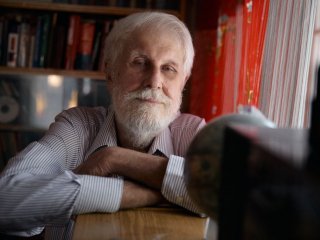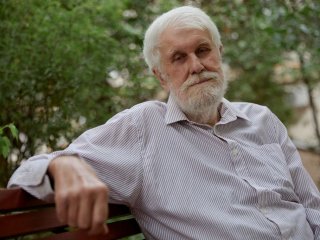How did the Moon come into being? Has this issue been finally settled? How much water is there in the solar system? Could life evolve in extraterrestrial oceans? What a geologist has to do with space? Why do we need research on distant satellites and planets? These questions are answered by Oleg Lvovich KUSKOV, a fellow of the Russian Academy of Sciences and chief researcher of the RAS Institute of Geochemistry and Analytical Chemistry named after V.I. Vernadsky.
– Oleg Lvovich, you have devoted yourself to the cosmochemistry of the solar system planets, their origins, formation and chemical composition. Would you say all scientists share a common viewpoint concerning the formation of the Earth-Moon system or are there still controversies to be resolved?
– Let's start off with more trivial issues. How much do we actually know if we consider the solar system planets narrowly without talking yet about distant exoplanets? After all, only a few parameters had been measured before the space exploration era. One could measure a planet radius. Sometime around the fifth century BC, Greek philosopher and scientist Anaxagoras delivered, as we say now, an offline speech at a conference – there was no Zoom back then. He posited his hypothesis that the Sun is quite a large hot ball, larger than Peloponnesus. His audience and fellow scientists objected saying that was too much. Here you have the ancient concept of what the Sun was like.
Naturally, this knowledge evolved with time. We have gained a fairly solid fundamental scientific concept of planetary motion and planet dimensions, starting with the works of Galileo, Copernicus and Kepler, followed by Newton. But why did I start with Anaxagoras? Because throughout the entire pre-spaceflight era, only a few parameters had been measured – the planet radius, its mass, the solar energy flux and, quite recently, age. After all, it was extremely difficult to understand how old the Earth is.
We’ll have to recall history once again. In the late 19th century, when Darwin published his magnum opus, On the Origin of Species, he understood that it had taken quite a long time for species to evolve. It was at that point that the famous English physicist Thompson had calculated the Earth’s age. As a fair scientist, he estimated that the age of the Earth ranges somewhere between 20 million years and 400 million years.
It was an absolutely shocking discovery for Darwin who understood quickly as a biologist that the evolution of life cannot happen in such a short time span. That’s how important age is.
And Thompson did everything honestly and proceeded from state-of-the art knowledge in science of that time. He relied on the concept of heat transfer in the form of heat conductivity, knowing nothing about the existence of radioactive elements which had yet to be discovered by the close of the 19th century by Becquerel.
Then the Earth’s age began to increase gradually. Finally, we have come to the point that the age of today’s Earth is about four and a half billion years. And when space research began, of course, we learned a lot more. What do we know about the Earth, about the Moon, less so about other planets? First of all, it is, of course, petrological and geochemical findings we have thanks to spacecraft returning from the Moon.
The first launch to the Moon was carried out in 1959, and 10 years later the Soviet missions Luna 16, Luna 20 and Luna 24 came back with 300 grams of lunar soil in total. Back then, I was still a young research associate. All that lunar soil came to our Institute. We had a special room with a round-the-clock guard posted at entrance. No one could walk past the guard. And all our geochemical scientists expected new results with great enthusiasm.
At the same time, or actually a bit earlier, in 1969, Apollo 11 was launched with three astronauts aboard who had returned with a bigger 21-kilogram load of lunar soil. Exchange between Russian and American scientists, our partners, began. There was such a euphoric sentiment in science when extraterrestrial matter was first delivered.
Of course, meteorites fell onto the Earth before. But even while there had been a variety of meteorites, e.g., iron, stone, chondrites, achondrites, here we had a sample of matter from our closest satellite. It turned out that a number of amazing discoveries were just waiting to be uncovered by geochemical analyses. This is as far as the sciences of petrology and geochemistry are concerned.
Yet, no less important are seismic surveys. For the Earth, these surveys began in the very beginning of the 20th century, when English scientist Oldham first discovered the existence of the Earth’s core using seismometers. It was a very significant discovery.
As it was known that iron meteorites fall onto Earth, it was suggested that Earth’s core consists of the same material as iron meteorites. That is, the core bulk is ferronickel alloy. Seismic surveys are a Rosetta Stone of sorts for Earth studies.
The same research was performed later on the Moon as a result of the six lunar Apollo missions.
– Is it certain by now what the Moon consists of?
– It consists of so-called regolith or megaregolith. It’s a thick layer of refined dust covering the entire surface of the Moon. And it should be mentioned that a lively debate had unfolded before the Soviet flights to the Moon: is the Moon solid? Scientists understood that dust existed and speculated that mooncraft could sink in it after landing.
Then Sergey Pavlovich Korolev made his strong-willed decision. He said: “Let us assume that the Moon is solid”. This was exactly what it turned out. And the rocks of the lunar surface comprise mare rocks, which are primarily basalts underlying continental rocks. These rocks feature a particular mineral – anorthosite. They make up the crust. Moon’s crust is quite thick, about 30-40 kilometers, making it just as thick as the Earth’s crust.
There is a mantle beneath the crust – a solid, rocky component comprising the same rocks that are characteristic of the Earth as well.
It is quite another matter that the Moon is much smaller than Earth. For that reason its deeper strata experience a much smaller pressure. To make a clear comparison, the pressure in the center of the Earth is about three and a half million atmospheres. And on the Moon, it’s several hundred times smaller. To sum up, both the Earth’s and the Moon’s rocks are similar to some extent.
Yet, there is a concept of phase transitions. What exists at the Moon as low-pressure phases, becomes high-pressure phases on the Earth. The Moon radius is 1737–1738 kilometers. Its mantle extends to the depths of about 1400 kilometers. Beneath the mantle lies the so-called central part of the Moon, which includes a core discovered indirectly using survey data from the Apollo spacecraft. And this core is covered by a partially molten shell, which is a mystery.
– Is there no such shell on Earth?
– There is one. This is a layer from which strong plumes rise that extend almost to the surface of the Earth in the form of hot-spot areas. They are like volcanic eruptions. The structures of the Moon and the Earth are similar.
– But what is the mystery then?
– The mystery is why the Moon has a core, what is its composition, phase and physical state? For the Earth, the nucleus is known to consist of two components: the solid inner core and the liquid outer core. And all ferronickel rock has so-called light or alloying elements added in the form of sulphur, carbon, silicon, oxygen.
Furthermore, the Earth has a magnetic field that is maintained by the very convection in the planet’s liquid core. Life on Earth has evolved thanks to the magnetic field as the latter shielded the atmosphere, the ionosphere.
And there is no magnetic field on the Moon. Overall, the Moon is a small body. But according to contemporary data, the Moon also has a small inner core and a liquid outer core measuring approximately 300-350 kilometers across. And the Earth’s core measures three and a half thousand kilometers. To put that in a context, the Moon’s radius is about four times smaller than the Earth’s radius.
– Is there any final stance on the Moon formation upheld by all scientists?
– Probably one of the earliest hypotheses of the Moon’s origin belongs to Charles Darwin’s son, who suggested that the Earth and the Moon existed together in a dumbbell-shaped body in the distant past, with the Earth at the larger end and the Moon at the smaller end. Rotational motion caused this smaller part of the dumbbell to break away and become the Moon. And four and a half billion years ago, the Moon orbited the Earth at a much smaller distance. Now the distance between the Earth and the Moon is, roughly speaking, 400 thousand kilometers. Back then, it was dozens of times smaller.
– Does that mean the Moon is moving away from us?
– It moves away, of course, but so slowly that we cannot discern. So the people inhabiting Earth will be able to enjoy the sights of the Moon for a long time.
Darwin’s hypothesis was refuted by mathematicians, including the Russian mathematician Lyapunov, who proved it was impossible on the basis of a strict mathematical apparatus.
Another hypothesis came up, based on the premise that the Moon was captured by the Earth. The Earth is a big body. It has a great gravitational potential. It could attract the still-forming Moon and capture it. That is not an outlandish assumption. A number of satellites share a similar fate, e.g., Triton was captured by Neptune. So are Phobos and Deimos orbiting Mars, which were probably also captured by the larger planet. Whether it’s true or not, I’m not certain and I think few people know for sure.
But, with regard to the Moon capture, the skepticism of scientists is quite great. This hypothesis has not been completely refuted but it is not supported enthusiastically. It is believed that the probability of such a capture is extremely low.
Later, another hypothesis was posited, which was mainly developed by Soviet scientists at the Institute of Earth Physics. They were spouses, Viktor Sergeyevich Safronov and his wife, Evgeniya Leonidovna Ruskol.
– As far as I know, Evgeniya Ruskol had her postgraduate studies under Otto Yulyevich Schmidt.
– Yes, he had several outstanding postgraduate students. Female researchers were prominent at the Institute of Earth Physics at the time.
So, Evgeniya Leonidovna put forward a hypothesis called “co-accretion.” Co-accretion is a kind of a concurrent accretion of the Earth and the Moon matter from a primordial swarm of bodies. Imagine there had been no Earth yet. There was only the Sun surrounded with dust and some gas. The gas dissipated gradually, it was removed, it escaped, and solid dust began to stick together as a result of physical-chemical and mechanical collisions. These were minute, micrometer-sized specks at first, later growing to millimeters. Later they snowballed and compacted. All this was quite a long process, spanning millions of years.
And the Earth began to grow. Because it somehow got ahead in this growth, it captured the surrounding substance. More and more dust settled on the Earth due to the planet’s gravitational potential. And somewhere in its orbit, the Moon grew slowly too. The Earth and the Moon distributed a certain amount of matter among themselves. The Earth grew larger, and a smaller Moon grew nearby.
This hypothesis was very popular. In any case, nothing better had been proposed. Still, it faced a number of contradictions, both geochemical and physical, that failed to fit into this picture of the planet and its satellite growing simultaneously.
The hypothesis had remained mainstream until around mid-1970s, when a group of American scientists put forward the giant impact hypothesis at a famous conference in Hawaii.
They suggested that the Earth had grown close to its contemporary size when it suffered a giant collision with some other celestial body, its size similar to that of Mars.
The Mars radius is about half that of the Earth. But it’s still a giant body. This collision virtually broke Earth apart, probably denuding its core. A huge release of terrestrial and Martian matter had followed.
– If I am correct, the planet that struck Earth is called Theia.
– In honor of a Greek goddess, daughter of Zeus and Gaea. And that Theia had completely destroyed the Earth. There had been a highly energetic release of the Earth’s substance into the orbit. Theia’s substance was released at the same time. According to the first version of this hypothesis, the Moon substance was formed mainly from the impactor substance, i.e. from Theia.
– Is there some other version of this hypothesis?
– This hypothesis has multiple variants. But questions still abound. What kind of impact was that? Was that a head-on collision or did the body hit the Earth tangentially? Quite a lot depends on these details. A head-on collision would definitely split Earth through its core. In contrast, the Earth, albeit escaping scarred, would survive a tangential impact. Details aside, the canonical hypothesis assumes that lunar matter owes its existence to the impactor.
This story had been very popular until it faced counterarguments of geochemical order. Difficulties mainly came not from mechanics but specifically from geochemistry. What’s the matter?
If we have an impactor, it had to originate in a kind of a pool where all planets were formed. So Theia had been formed somewhere in its orbit. Some gravitational perturbations then sent it on a collision course with Earth.
– Is that even possible?
– Yes, it is quite probable. It is known, for example, that Jupiter, with its powerful gravitational field, can sling planets, move them from orbit to orbit. Among other things, it is held that Mars is so small because Jupiter’s gravitational field prevented it from growing. It is quite possible that Jupiter, using its powerful potential, had diverted Theia toward the Earth.
But then, as geochemists assert, Theia had to have quite a different elemental and isotopic composition than does the Earth. This conjecture was reiterated by Academician Ye. M. Galimov who developed his own hypothesis of the joint evolution of the Earth-Moon system.
– But the composition wasn't different, was it?
– This had remained unclear up to the recent decade. The fact is that mass spectrometry methods are being improved all the time to study the isotopic composition of lunar and terrestrial rocks. Scientists have measured the isotopic element composition of all those chemical elements of interest to them. Also it has turned out that lunar and terrestrial rocks share a common isotopic composition in terms of oxygen, silicon, titanium and tungsten, together with a number of other properties. This contradicts the predictions of the canonical model positing the Moon to have resulted from a giant impact.
On the other hand, problems arise not only with isotopic composition, but also with chemical composition.
There are five major oxides. An oxide is a compound of some element with oxygen. So our Earth, roughly speaking, consists of 50% silicon oxide. One can say we see silicon oxide every day, it’s sand. The rest of oxides account for a much smaller fraction of matter. There are only four of them: ferrous oxide, magnesium oxide, aluminum oxide, and calcium oxide. Apart from rare and trace elements, these five oxides comprise the bulk of matter in any inner planet of the Solar System.
And it turns out that the Earth and the Moon have different amounts of ferrous oxide. And that is really very important. While ferrous oxide makes up eight percent of the Earth, it is one and a half times more abundant on the Moon. Most of the experimental data obtained using rock samples and a vast majority of theoretical studies show that there is about one and a half times more ferrous oxide on the Moon.
A paradox arises: if the isotopic composition of silicon, oxygen, chromium and titanium is identical for the Moon and the Earth alike, that suggests the lunar substance should have been derived from Earth’s mantle. Yet, the most abundant elements, iron and oxygen, combining into ferrous oxide, occur one a half times more frequently on the Moon. So how could the Earth’s substance give rise to the lunar substance? It is very difficult to understand how such a separation of ferrous oxide between the Earth and the Moon could occur.
This difficulty could be dealt with conveniently by assuming that a certain Theia had formed elsewhere in the orbit, in a different space. It had a different chemical composition but had the same isotopic composition. In short, as you can see, there are many assumptions, but the final truth has not yet been established.
– Oleg Lvovich, it is known that Russia is about to resume its lunar program and will revisit the Moon for research, which may shed some light on all those mysteries. Tell me, please, how do you feel about plans to use lunar resources to solve the energy and other problems of the mankind?
– In lunar studies, as we know, China has gotten ahead very much. Their series of Chang’e spacecraft has deployed Yutu lunar rovers to comb the surface of the Moon. At first, they landed on the far side of the Moon which is a colossal achievement per se, and took a number of wonderful pictures, explored and charted the lunar surface. A year ago, Chang’e 5 brought back, if I am correct, 713 grams of lunar rock. That is, China has made immense strides in lunar research and they are now launching spacecraft to Mars. They have very ambitious programs.
I don’t have much to comment on the Russian programs as we constantly face all kinds of delays, something ends up being postponed all the time, so what will materialize is uncertain. If Mr. Rogozin is to be believed, a launch is planned for this fall. But, as they say, let’s live to see it first.
You see, there are no young people who pursue a scientific career, no engineers. Furthermore, we face a lack of blue-collar workforce, for there is a lot of delicate fitting, milling and turning work involved. Back then, we had an entire engineering and technology department at the Institute where there engineers and workers machined totally unique parts for the instruments to be sent to the Moon. They made their own instruments, mass spectrometers. As a result, we had our greatest achievements in the field of exploration of the Moon and Venus where real miracles were done.
I remember when our then-director, Academician Alexander Pavlovich Vinogradov, delivered his first report on the composition of the Venusian atmosphere. No one knew exactly what the atmosphere of Venus consisted of, what its density was, what the atmospheric pressure was, what temperature was there on Venus. He said that the Venusian atmosphere consisted of carbon dioxide, and the surface-level pressure was one hundred times greater than on the Earth. The Earth pressure is one atmosphere, and there the pressure is 100 atmospheres. It’s also terribly hot, more than four hundred degrees Centigrade. We were shocked. And now what? Now we are watching the achievements of Elon Musk and the Chinese.
– Oleg Lvovich, I know that, beside the Moon, you are also researching Jupiter. In your opinion, what are the most interesting results findings of research in that area?
– If we refrain from venturing into distant history and stay closer to our days, sizable achievements were made as a result of the Galileo mission, which was launched to Jupiter and for several years investigated the system of Jupiter and its satellites known as the Galilean moons. Prior to this mission, all astronomy textbooks stated that Jupiter had 16 satellites, including the four larger moons. Let me name them: Io, Europa, Ganymede, and Callisto.
As a result of spacecraft missions, more than 60 satellites of Jupiter have become known. But still the four moons are considered the largest.
Before spacecraft reached Jupiter, theoretical scientists studying outer space had suggested that one of the Jovian moons, namely Io, experienced quite strong volcanic activity. When spacecraft got there, it turned out to be true. Today we know that Io is the largest volcano in the solar system. Lava fountains several dozen, maybe even several hundred kilometers high erupt into Io’s tenuous atmosphere. Io is a hot body with a size very close to the Moon, they are practically twins. Io is about the same distance from Jupiter as the Moon is from the Earth. Their radii and densities are close. Both are iron-rock planets, the difference being that the Moon is a passive body.
If Io is an iron volcano, the other three moons are ice-and-rock satellites. This is entirely true for Ganymede and Callisto, and to a lesser extent, for Europa. Europa also resembles the Moon in terms of its radius. Its density is slightly lower than that of the Moon. But the density of Ganymede and Callisto is two grams per cubic centimeter. This value suggests they are half-rock, half-ice or liquid water. The latter was the most prominent discovery of the Galileo mission.
Photographs were taken and the entire surface was charted. Europa has a streaked surface, presumably indicating its cryovolcanic activity. The ice crust covering Europa breaks up due to some tectonic movements, and liquid water is released. Europa is believed to certainly have an inner ocean under its ice shield. The depth of this ocean defies precise measurement; estimates range between a dozen and a hundred kilometers. Europa is of great interest. Hardly a day passes without a project for sending a spacecraft there so that it would land on the icy surface, take a smear and analyze the sample for the presence of microbial life using an advanced mass spectrometer.
Actually, if all planets and satellites used to be of interest for geochemists, geophysicists, and geologists in the past, the focus is now moving towards biology and astrobiology. To that end, such launches are absolutely necessary because they can help answer the question of how life appeared, why it appeared. It is very difficult to understand why life originated on the Earth. But if we succeed in discovering life beneath the rocks of Mars, somewhere under the Martian surface, on Europa, or on a wonderful satellite of Saturn like Enceladus, where water geysers shoot up from an icebound ocean, it will be the greatest discovery pursued by scientists around the world.
– Oleg Lvovich, let’s talk now about the contribution of the Institute of Geochemistry and Analytical Chemistry to these studies.
– We have been dealing for many years with the internal structure of the satellites of Jupiter and Saturn’s largest moon, Titan. Each satellite is unique in its own way, and that makes it interesting. Titan is the only body in the solar system and generally the only satellite that has an atmosphere. Galilean moons do not possess such an atmosphere. The Titanian atmosphere consists of almost 98% nitrogen. While nitrogen only makes up about 80% of the Earth’s atmosphere, the Titanian atmosphere can be said to be completely made of nitrogen. Other gases account for about 2%. Titan is covered with seas or lakes that consist mainly of methane. Methane is what we consume in gas burners, it is a hydrocarbon that contributes so much to Russia’s wealth, and there is a lot of it on Titan. These are liquid seas.
It is very cold on Titan, like on the Galilean moons, where the temperature is about 100 kelvins. Still, there are ongoing attempts to discover life on those satellites. In contrast, our concern was mainly the internal structure – we tried to understand what was inside those largest satellites in the solar system.
All of those are Moon- or Mercury-sized, making them rather large celestial bodies. As I mentioned earlier, they often feature both liquid water and ice. Ice takes different forms. We, on the Earth, are mostly familiar with “our” ice, while the inner layers of large satellites experience phase transitions when pressure restructures normal ice into a high-pressure phase. At the same time, we crucially need to know whether a liquid ocean can exist under the ice crust of those satellites. All satellites are covered with solid ice crust, its thickness varying from tens to hundreds of kilometers. But is there a liquid ocean under the ice crust of all those moons?
We are trying to clarify this issue, and we can see that there may be a liquid ocean on all the satellites of Jupiter and Saturn. The composition of it is not very certain. It’s mainly liquid water, of course. It is less likely to be fresh water though. All oceans and all seas on the Earth are saline, they contain relatively large amounts of sodium chloride. The same can be said of the existence of oceans on those satellites. They can, of course, contain various dissolved gases – methane, carbon dioxide, dissolved salts. They may contain ammonia. The thickness of the ocean itself and that of the overlaying ice crust would depend on particular admixtures in the ocean.
Both planets used to possess a dense shell, what we call a mantle, that is, a solid iron-and-stone rock. Whereas the satellites of giant planets may be of a completely different structure, featuring an ice-covered surface, quite a massive ocean beneath, probably hundreds of kilometers deep, and a core of pressurized ice and stone rock underlying this ocean. The mantle is not completely separated, so we have to rely on the terms poorly understood by the general public, such as partially differentiated satellites. It means there has been no separation of stone, rock, and ice. At the same time, these satellites exhibit fundamentally different structures. And we still have a lot of questions to be answered.
– Oleg Lvovich, why is such research important for us, the Earth dwellers?
– Anaxagoras tried to measure the size of the Sun. One may ask why he needed it. He was curious. Here’s the answer to your question. Scientists are doing it because it is of interest to them. Their work is motivated by an idea.
– But after all there are people – the majority of us – for whom this matter is completely irrelevant. Why does the mankind need it, what will it gain?
– This is probably an eternal question. Why did the physicists split the atom? Didn’t they have anything else to do? Perhaps they could grow tomatoes. No, they chose to split the atom. What did that lead to?
– This has led, among other things, to the creation of numerous machines and equipment, including medical instruments, which have since become indispensable for our lives.
– You are perfectly correct. Here is another analogy from science. When Michael Faraday performed his experiments, he had the simplest equipment one can imagine. Iron wire, stools. He designed primitive Faraday’s coils. And he had no money. He turned to the Treasury for a grant, as we would now say. Some official came to his lab, looked at all this rusty equipment and said: “What will it give us? What is the benefit to the country?” To that, Faraday responded, “In a few years you will be collecting taxes from my discovery of electricity.”
A few decades before Faraday, all British newspapers came out with a macabre headline that the world would soon plunge into darkness. Why? Because candles were made of whale fat. It was predicted that when the last whale is killed, the world would plunge into total darkness. And here came Faraday, there was electricity, there was light.
Had there been no Faraday, no electricity, the world would indeed plunge into darkness. So here is the answer to your question – why do the deep people need it or, so to speak, the mankind?
– That is, the curiosity that drives scientists makes us all enjoy really important discoveries and applications.
– Yes. Including personal computers, smartphones, the Internet, and us being able to converse now via Zoom.
Interviewer: Natalya Leskova
Photo: Nikolay Malakhin
Video: Aleksandr Kozlov

































